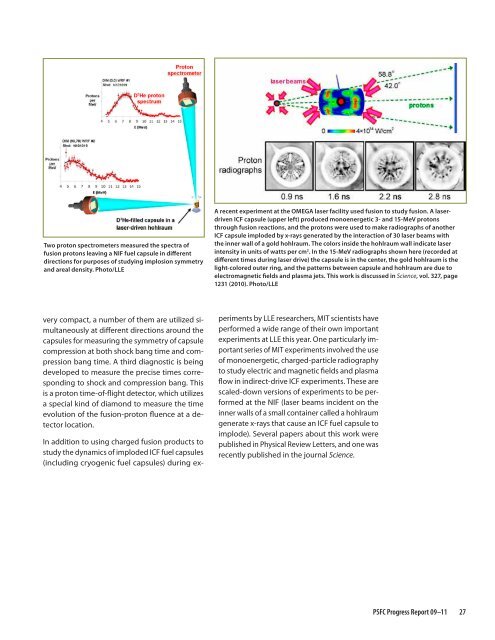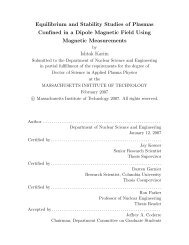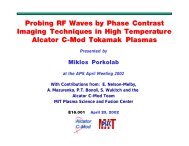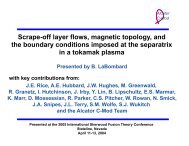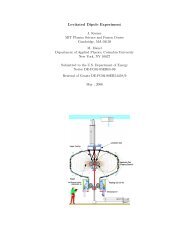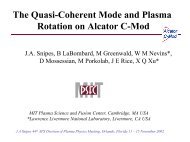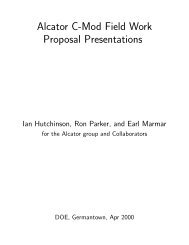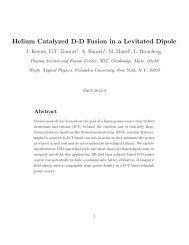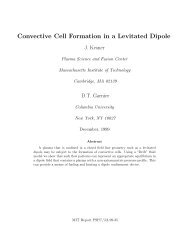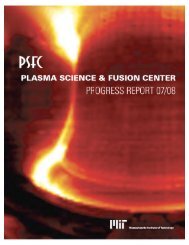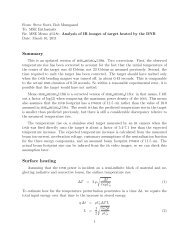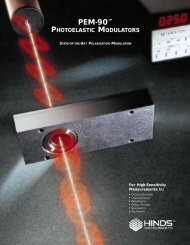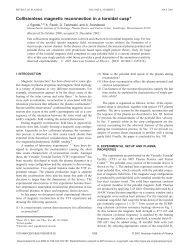Download a copy of the latest PSFC Progress Report - Plasma ...
Download a copy of the latest PSFC Progress Report - Plasma ...
Download a copy of the latest PSFC Progress Report - Plasma ...
You also want an ePaper? Increase the reach of your titles
YUMPU automatically turns print PDFs into web optimized ePapers that Google loves.
Two proton spectrometers measured <strong>the</strong> spectra <strong>of</strong><br />
fusion protons leaving a NIF fuel capsule in different<br />
directions for purposes <strong>of</strong> studying implosion symmetry<br />
and areal density. Photo/LLE<br />
A recent experiment at <strong>the</strong> OMEGA laser facility used fusion to study fusion. A laserdriven<br />
ICF capsule (upper left) produced monoenergetic 3- and 15-MeV protons<br />
through fusion reactions, and <strong>the</strong> protons were used to make radiographs <strong>of</strong> ano<strong>the</strong>r<br />
ICF capsule imploded by x-rays generated by <strong>the</strong> interaction <strong>of</strong> 30 laser beams with<br />
<strong>the</strong> inner wall <strong>of</strong> a gold hohlraum. The colors inside <strong>the</strong> hohlraum wall indicate laser<br />
intensity in units <strong>of</strong> watts per cm 2 . In <strong>the</strong> 15-MeV radiographs shown here (recorded at<br />
different times during laser drive) <strong>the</strong> capsule is in <strong>the</strong> center, <strong>the</strong> gold hohlraum is <strong>the</strong><br />
light-colored outer ring, and <strong>the</strong> patterns between capsule and hohlraum are due to<br />
electromagnetic fields and plasma jets. This work is discussed in Science, vol. 327, page<br />
1231 (2010). Photo/LLE<br />
very compact, a number <strong>of</strong> <strong>the</strong>m are utilized simultaneously<br />
at different directions around <strong>the</strong><br />
capsules for measuring <strong>the</strong> symmetry <strong>of</strong> capsule<br />
compression at both shock bang time and compression<br />
bang time. A third diagnostic is being<br />
developed to measure <strong>the</strong> precise times corresponding<br />
to shock and compression bang. This<br />
is a proton time-<strong>of</strong>-flight detector, which utilizes<br />
a special kind <strong>of</strong> diamond to measure <strong>the</strong> time<br />
evolution <strong>of</strong> <strong>the</strong> fusion-proton fluence at a detector<br />
location.<br />
In addition to using charged fusion products to<br />
study <strong>the</strong> dynamics <strong>of</strong> imploded ICF fuel capsules<br />
(including cryogenic fuel capsules) during ex-<br />
periments by LLE researchers, MIT scientists have<br />
performed a wide range <strong>of</strong> <strong>the</strong>ir own important<br />
experiments at LLE this year. One particularly important<br />
series <strong>of</strong> MIT experiments involved <strong>the</strong> use<br />
<strong>of</strong> monoenergetic, charged-particle radiography<br />
to study electric and magnetic fields and plasma<br />
flow in indirect-drive ICF experiments. These are<br />
scaled-down versions <strong>of</strong> experiments to be performed<br />
at <strong>the</strong> NIF (laser beams incident on <strong>the</strong><br />
inner walls <strong>of</strong> a small container called a hohlraum<br />
generate x-rays that cause an ICF fuel capsule to<br />
implode). Several papers about this work were<br />
published in Physical Review Letters, and one was<br />
recently published in <strong>the</strong> journal Science.<br />
<strong>PSFC</strong> <strong>Progress</strong> <strong>Report</strong> 09–11 27


